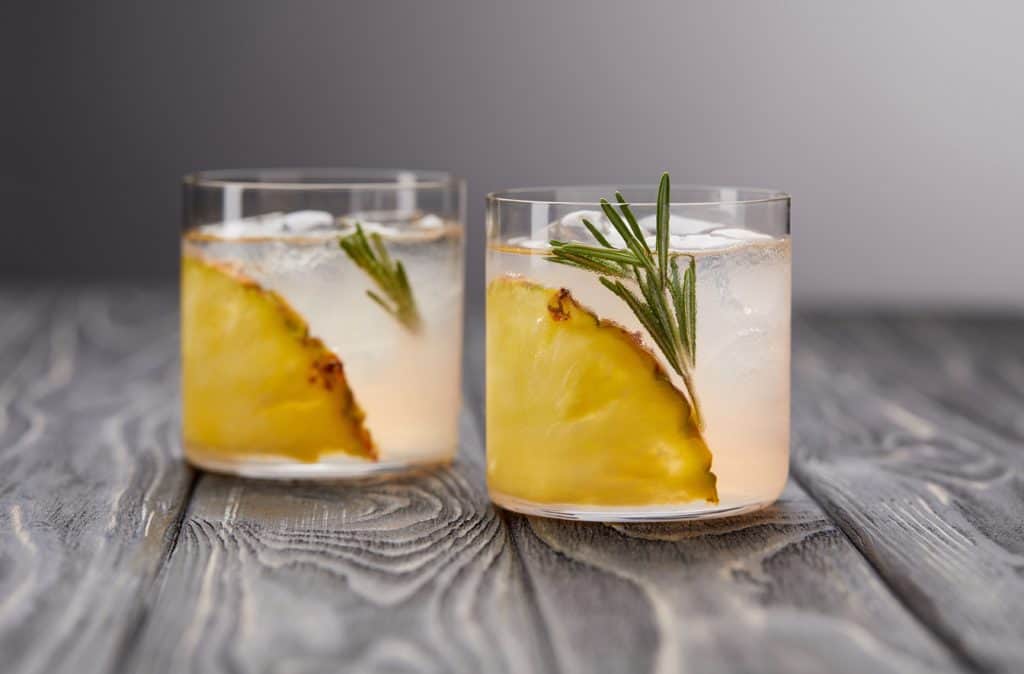![How to Make Tepache [Fermented Pineapple]](https://myfermentedfoods.com/wp-content/uploads/2018/10/Resized_Depositphotos_199335452_ds-1024x682.jpg)
Pineapple Tepache is a light and refreshing probiotic drink which originated in Mexico. Its juicy and sweet taste makes it perfect drink for parties and get togethers.
It is made from the peel and the rind of pineapples. The mixture is later sweetened with a form of unprocessed brown sugar popularly called piloncillo by the native Mexicans. The molasses-like flavor of piloncillo adds to the rich complex taste of tepache.
As with most other culinary delights from Mexico, the origin of tepache can be found in the Pre-Columbian period of the Mesoamerican region. The term “tepache” is derived from the Nahuatl word tepiātl that means a drink prepared from corn.
This is so because, originally, natives used corn to create a drink similar to Tepache that we prepare now with pineapple.
Though the corn drink exists even today and is known by names such as tejuino in Mexico and Chicha de Jora in South America, it is the Tepache made from Pineapples that has become more popular than its original counterpart.
The naturally sweet and sour taste of pineapple coupled with the medicinal compounds like Bromelain present in it has caused a shift in the use of this fruit in place of corn.

Tepache benefits
Most of the benefits of Tepache can be attributed to the presence of vitamins, minerals, and a powerful medicinal compound called Bromelain in pineapples.
- Bromelain from pineapples contains a mixture of components such as phosphatase, and cellulase that exhibit an antithrombotic activity. The antithrombotic activity of the medicinal components of bromelain refers to the ability to prevent the abnormal formation of clots in the vessels. This action of Bromelain could be beneficial for people who are at risk of developing stroke and heart attacks.
- Recent pre-clinical studies have indicated that tepache possesses natural anti-cancer potential. It can be used by patients with cancer who are undergoing radiation or chemotherapy. Tepache would support the body’s natural ability to destroy cancer cells thereby supporting the faster recovery of patients.
- Bromelain in tepache can act as an anti-inflammatory agent. This means it may protect your body’s organs and tissues against damage by reducing swelling and redness. This action of tepache may help to relieve joint pains caused due to arthritis, as well as other painful conditions such as migraines, gout, and so on.
- You will be surprised to know that drinking Tepache regularly may improve your skin health. It may make your skin appear more vibrant and glowing. It can restore the natural beauty of your skin by healing acne breakouts, wounds, and ulcers. It can also slow down the signs of aging and help you look much younger than your actual age.
- Pineapple contains a large amount of dietary fibers that are essential for keeping your intestines healthy. It can promote the digestive functions and provide relief from bloating, flatulence, constipation, and indigestion. It can also boost the digestion of food and urinary functions thereby easing symptoms like stomach upsets, and pain during urination.
- A complex mixture of bioactive compounds in pineapples may help reduce the risk of osteoarthritis. Bromelain present in this fruit can protect the joints against inflammation and age-related wear and tear. It can also protect the joint surfaces against excessive friction caused due to the rubbing of the bones against each other during movements. This action can promote the longevity of the bones and joints and prevent osteoarthritis.
- This is not all. It also offers other potential benefits such as improving immunity, supporting heart functions, and preventing infections.
Is tepache alcoholic?
Though tepache is made by fermenting pineapples, the resulting beverage does not contain much alcohol. In fact, if you ferment it for long, it will get closer to vinegar that is considered a healthy ingredient to add to your cooking. However, the alcohol content of Tepache may increase if you add brewer’s yeast to the pineapple chunks during fermentation.
Print
Pineapple Tepache Recipe
- Total Time: 15 minutes
- Yield: 2 quarts 1x
Description
Pineapple Tepache is a light and refreshing probiotic drink which originated in Mexico.
Ingredients
- 1 pineapple cut into chunks
- 1 cup brown sugar
- 8 cups water
Instructions
- Cut the head off of the pineapple and discard it. Wash pineapple thoroughly ensuring that any dirt particles or bugs are removed. Cut the pineapple in chunks keeping the skin on.
- In the glass jar pour water then add sugar. Mix the sugar until it fully dissolves.
- Add pineapple and cover mouth of the glass jar with the cheesecloth or tea towel and secure it with a rubber band.
- Keep the jar in a cool place away from direct sunlight for three days.
- After 2-3 days you will notice white foam starting to form on the surface of water. Scoop out the white foam with a spoon.
- Serve pineapple tepache over ice.
Notes
Equipment: large glass jar , chopping board, knife, spoon, cheesecloth or tea towel and a rubber band.
- Prep Time: 15 minutes
- Cuisine: Mexican
Nutrition
- Serving Size: 1 cup
- Calories: 106
- Sodium: 12 mg
- Carbohydrates: 25 grams
Variations of Pineapple Tepache
To spice up the traditional version of pineapple tepache you may try the below variations:
- Add stick of cinnamon or 2 cloves in the jar during the making process.
- To get an extra refreshing punch add a bit of freshly squeezed lime juice to the traditional pineapple tepache before serving.
- Add cuts of fresh fruits like pineapple or apples and decorate the glass by adding a straw and spoon.
Conclusion
You can make pineapple tepache easily within a few minutes on your kitchen counter. Keep in mind that as every fermented drink, pineapple tepache needs time to ferment which is approximately 3 days. The fermentation time depends on the temperature and ripeness of the pineapple.
Tepache has a very refreshing and energizing feel to it. It’s easy to make and a perfect summer drink.
Have you tried Tepache? Let me know in the comments below.

Can you use canned pineapple.
Pineapple peels are an essential ingredient to make the pineapple tepache hence you won’t be able to use canned pineapple.
My Tepache (first time) has been in the jar for 4 days now. How do I know it is “ready”?
Also, do you decant the actual drink into another jar/ bottle (without the pineapple bits) and keep in your fridge?
Thank you!
As it’s already day 4, you should see frothy white foam on the surface of the water. If the form is there it means tepache is ready. If you don’t see any white foam allow it to ferment for another day. Fermentation time for tepache depends on the room temperate and ripeness of the pineapple. Hope this helps!
Yes! I have been scooping the foam off. So it is ready 🥳
Should I pour it in another container (removing the pineapple)? Thank you
Yay 🙂 Strain out pineapple and transfer tepache into a glass bottle with a lid and refrigerate. You can keep it in the refrigerator for up to a week. Serve over ice (optional). Enjoy 🙂
I really want to make this today but do I uses the piloncillo when it calls for sugar or is this something that I add after?
Hi Betty, You can substitute one cup of brown sugar with one cup of piloncillo in the recipe.
Love this stuff!!! Why do I need to scrape the foam off? My pineapple tends to float to the surface and it’s quite difficult to get the foam off without removing the pineapple or mixing it all together.
Hi Kobi, Foam is usually harmless. If you find it difficult to remove it during the fermentation just scoop it off before bottling.
unfortunately, i made my tepache before reading your article. no one told me about the white foam and i didn’t know what it was (mold?) so i threw the tepache out. ☹